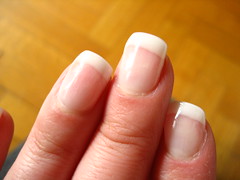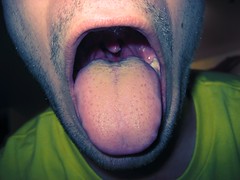Assess for his vital signs – temperature, pulse (rate and rhythm), respirations (rate, pattern, depth). Remember, neonates and adults have different range of vital signs as to what is mentioned above. Check also your patient’s blood pressure.
When checking the nutritional status, take note of his height and weight. The ideal body weight of men is 106 lb for the first 5ft; add 6 lb per inch subsequently. In women, 100 lb for the first 5 ft, then add 5 lb per inch. Consider adding 10% for patients with larger frame but do the opposite for those with smaller frames.
If you are assessing the skin, check pallor on buccal mucosa or conjunctivae, cyanosis on nail beds or oral mucosa, jaundice on sclera. Check for signs of scars, bruises, and lesions. Check around the eyes and sacrum for edema, moisture, or hydration. It is also important to assess for the skin’s temperature, texture, and turgor (check over sternum for the elderly).
If you are looking at his hair, does he have hirsutism (excessive hair), alopecia (loss or thinning of hair)? Note down what you see.
 |
| http://farm1.static.flickr.com/134/393504897_59eaabbd62_m.jpg |
Patient’s head size, shape, and symmetry should be normal. Look for the temporal arteries then check his cranial nerve function.
Does his eye have ptosis (drooping of upper eyelid)? Assess for the colour of the sclera and conjunctivae. His pupils’ size, shape, equality, reactivity to light and accommodation (PERRLA) should be normal. Does he have photophobia, nystagmus, and strabismus? Check for the corneal reflex, visual fields, visual acuity. When performing an ophthalmoscope exam, check for any red reflex. Observe the fundus, optic disk for blind spot, and the macula.
When you are in the ear area do the Weber test and the Rinne test. Check also his tympanic membrane. Pull the pinna up and back to examine children’s and adults’ ears. Pull pinna down and back to examine infants’ and young children’s ears.
The nose and sinuses are assessed for the septum midline. Look on the nose’s alignment, colour, or any discharge. Palpate and percuss sinuses.
 |
| http://farm1.static.flickr.com/114/308412308_0fa3c40534_m.jpg |
The neck is assessed for its range of motion of cervical spine, nontender cervical lymph nodes which are normal in less than 1 cm round, soft, and mobile. It is also assessed for the treacheal position, thyroid gland, carotid arteries, and jugular veins.
The thorax and lungs area are checked for the alignment of spine, anteroposterior to transverse diameter of the thorax, respiratory excursion, respirations, tactile fremitus, and diaphragmatic excursion. Breath sounds is noted. Normal breath sounds can be checked via vesicular, bronchovesicular, and bronchial. Adventitious breath sounds occurs as rales, ronchi, wheezes, or pleural friction rub. The area of assessment is also tested for its vocal resonance. Bronchophony, egophony, and whispered pectoriloquy are tested out. The costovertebral angle is examined by percussing.
When checking for the heart sounds you must be familiar with the different kinds of abnormal sounds. Write down what you hear from the diaphragm.
Continue the assessment in the peripheral vascular system. Check for pulses from all the different areas: radial, ulnar, femoral, carotid, pedal, porterior tibial, popliteal, temporal, and apical. It is necessary to observe for any Homan’s sign which is a test for thrombophlebitis which shows pain in the calf when dorsiflexing the foot.
Breasts and axillae are assessed for its size, shape, and symmetry. Locate if there are palpable nodes which indicated abnormality. If the breasts are enlarged in males it is called gynecomastia.
When assessing the abdominal area, make sure your patient‘s knees are flexed to relax the abdominal muscles and provide comfort. Inspect and auscultate, then percuss and palpate. Check for its symmetry and contour. Look over the umbilical area and note everything you observe. Note down bowel sounds and it should be in 5 to 20 intervals of gurgles. The aortic, renal, iliac, and femoral arteries are auscultated with the bell of the stethoscope. Check for any peritoneal friction rubs, rebound tenderness, and abdominal reflexes.
The neurological system is assessed for deep tendon reflexes, cerebral function, mental status, cranial nerve function, motor function and sensory function.
The musculoskeletal system is assessed for the muscle tone and strength, and joint movements.
Provide privacy when assessing the genitalia and use firm but deliberate touch. Note down all the necessary observations.

Here is a great herbal doctor who cured me of Hepatitis B. his name is Dr. Imoloa. I suffered Hepatitis B for 11 years, I was very weak with pains all over my body my stomach was swollen and I could hardly eat. And one day my brother came with a herbal medicine from doctor Imoloa and asked me to drink and I drank hence there was no hope, and behold after 2 week of taking the medicine, I started feeling relief, my swollen stomach started shrinking down and the pains was gone. I became normal after the completion of the medication, I went to the hospital and I was tested negative which means I’m cured. He can also cure the following diseases with his herbal medicine...lupus, hay fever, measles, body pain, dry cough, diabetics hepatitis A.B.C, mouth ulcer, mouth cancer, bile salt disease, fol ate deficiency, diarrhoea, cardiovascular disease, Neoplasms, chronic respiratory disease, mental and behavioural disorder, liver/kidney inflammatory, eye cancer, skin cancer disease, malaria, chronic kidney disease, high blood pressure, food poisoning, parkinson disease, bowel cancer, bone cancer, brain tumours, asthma, arthritis, epilepsy, cystic fibrosis, lyme disease, muscle aches, cholera, fatigue, muscle aches, shortness of breath, tuberculosis, alzhemer's disease, Rheumatoid Arthritis, Anxiety Disorders, Back Pain, Crohn's Disease, Chronic renal failure, acute myeloid leukaemia, acute pancreatitis, chronic inflammatory joint disease, inflammatory bowel disease, Addison's disease, back acne, breast cancer, allergic bronchitis, Celia disease, bulimia disease, congenital heart disease, cirrhosis, fetal alcohol spectrum, constipation, fungal nail infection, fabromyalgia, (love spell) and many more. he is a great herbalist man. Contact him on email; drimolaherbalmademedicine@gmail.com. You can also reach him on whatssap- +2347081986098.
ReplyDelete